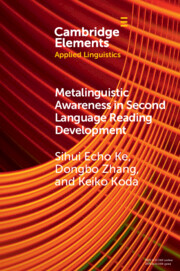Element contents
Metalinguistic Awareness in Second Language Reading Development
Published online by Cambridge University Press: 02 February 2023
Summary
- Type
- Element
- Information
- Series: Elements in Applied LinguisticsOnline ISBN: 9781108979801Publisher: Cambridge University PressPrint publication: 23 February 2023
References
- 14
- Cited by

